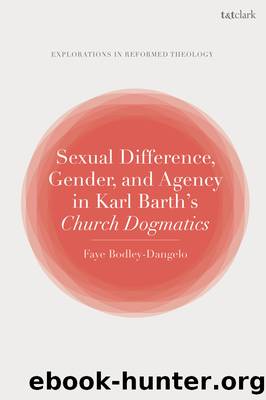Sexual Difference, Gender, and Agency in Karl Barth's Church Dogmatics by Faye Bodley-Dangelo;

Author:Faye Bodley-Dangelo;
Language: eng
Format: epub
Publisher: Bloomsbury UK
Re-animating Eve
In an extended and complex discussion of the figurative dimensions of the third scene, Barth traces a prefigurative arc that runs from Adam and Eve, to Yahweh and Israel, to the groom and bride of the Songs, and arrives finally at Christ and the Church. In following this arc, he makes a number of interpretive moves to support the privileged place he gives to the marital relationship, detached from the production of progeny. He disentangles the sexual relationship from a reproductive framework, secures its christocentric reference in the Ephesians 5 bridal metaphor for Christ’s relationship to the church, and locates in the Song of Songs the seeking, speaking, confessing (ecclesial) bride who is absent in Genesis 2. These interpretive moves are of particular significance for my critical intervention into his account for a couple of reasons. First, Barth weaves together Scriptural support for the privileged place that sexual difference and the marital relationship occupies, but in the very process of so doing he destabilizes sexual difference by detaching it from any naturalizing or reproductive discourses. One result will be an account of sexual difference that is highly unstable and far more open-ended than Barth wants to allow. Another result will be that marriage itself acquires a very tenuous connection to Christ. Second, Barth finds the voice of the bridal church prefigured, not in Eve, but in the seeking, choosing, speaking female agent of the Song of Songs. However, in so doing he undermines the claims he has already made about the significance of Eve’s silence and her consent to refrain from free decision. He thus presents an incoherent account of female agency that we will continue to see in Church Dogmatics III/2 and III/4.
Peering out from the second creation narrative toward covenant history, Barth finds the dominant Old Testament picture of the sexual relationship not in the Edenic scene but in a relationship gone tragically wrong (and we might ask, how could it do otherwise under the terms Barth has set for its ordering?). For in the Old Testament’s many snapshots of the sexual relationship Barth finds a divinely prescribed order utterly distorted by “conflicts between the blind dominion of man and the jealous movement for feminine emancipation” (310). He here uses the language of envy that features whenever he speaks of contemporary feminist activity, for when she is not consenting to the aims of male decision-making, woman is expressing her envy of a prerogative that she has mistaken for a slight to her dignity, or so Barth imagines.
Furthermore, within the Old Testament the theological significance of this unhappy disorder is inseparable from and prefigures the tragic situation of a God envisioned by the prophets as the seeking, desiring, electing, long-suffering husband, who remains faithful to the singular marital covenant he has established with an adulterous, harlot wife—whose desire is ever directed elsewhere and never reciprocates in kind. The histories of both the Yahweh-Israel covenantal relationship and the man-woman relationship gesture reciprocally to the other in both their misery
Download
This site does not store any files on its server. We only index and link to content provided by other sites. Please contact the content providers to delete copyright contents if any and email us, we'll remove relevant links or contents immediately.
Signature in the Cell: DNA and the Evidence for Intelligent Design by Stephen C. Meyer(2879)
Real Sex by Lauren F. Winner(2873)
The Holy Spirit by Billy Graham(2782)
The Secret Power of Speaking God's Word by Joyce Meyer(2760)
The Gnostic Gospels by Pagels Elaine(2402)
Jesus by Paul Johnson(2232)
Devil, The by Almond Philip C(2207)
23:27 by H. L. Roberts(2144)
The Nativity by Geza Vermes(2120)
Chosen by God by R. C. Sproul(2058)
All Things New by John Eldredge(2052)
Angels of God: The Bible, the Church and the Heavenly Hosts by Mike Aquilina(1871)
Angels by Billy Graham(1845)
The Return of the Gods by Erich von Daniken(1843)
Knowing God by J.I. Packer(1727)
Jesus of Nazareth by Joseph Ratzinger(1710)
Evidence of the Afterlife by Jeffrey Long(1707)
The Gnostic Gospel of St. Thomas by Tau Malachi(1682)
How To Be Born Again by Billy Graham(1673)
